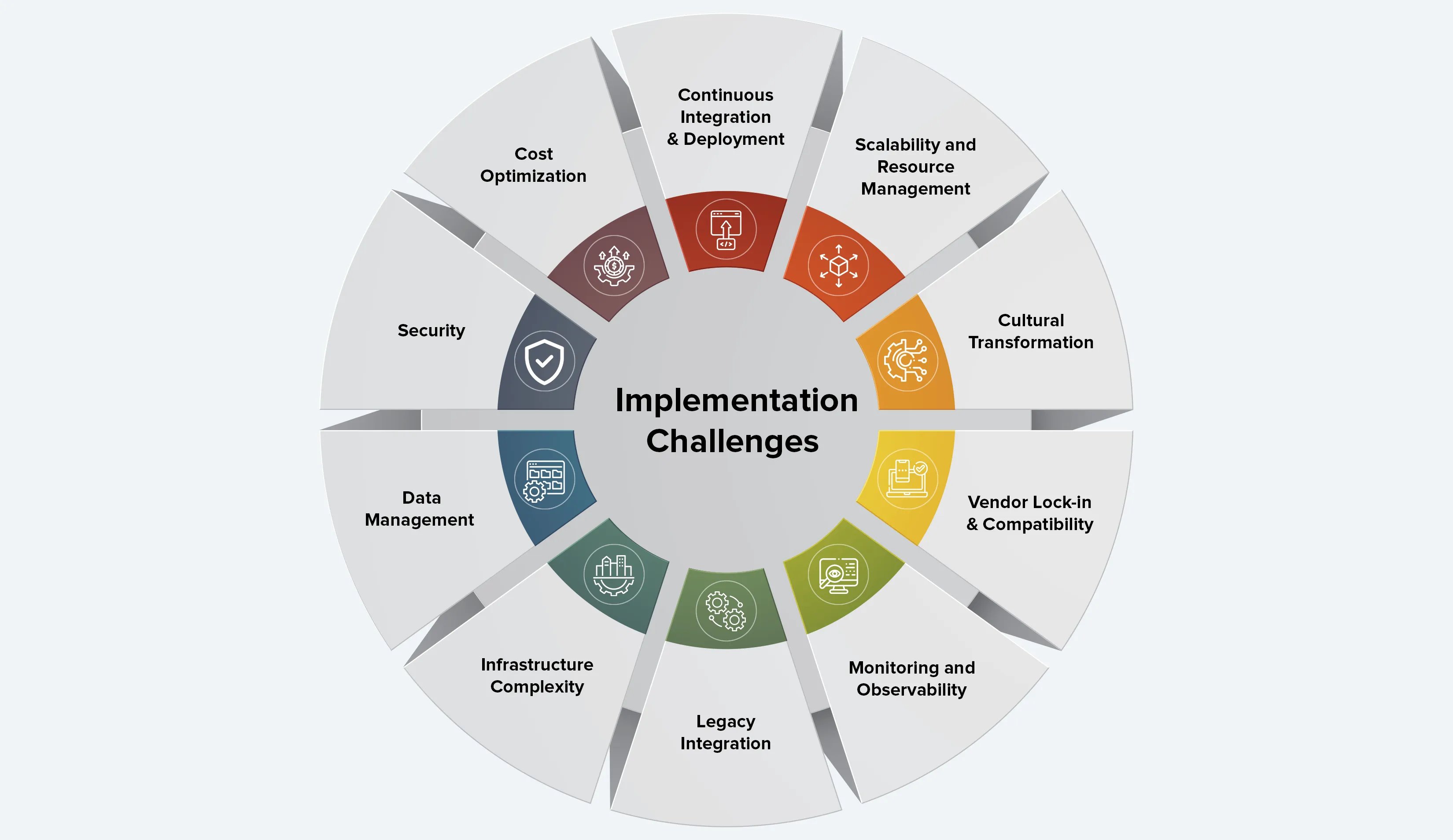The shift towards cloud-native architecture has gained significant momentum as organizations worldwide recognize the transformative power of cloud computing. By harnessing the power of cloud computing, businesses can unlock a plethora of benefits, enabling them to thrive in today's evolving technological landscape.
With the increasing adoption of cloud computing, it is no surprise that a significant number of organizations, estimated to be over 32% in 2020, are transitioning to cloud-native architecture. This shift is driven by the realization that leveraging cloud resources empowers businesses to develop and deploy highly scalable, resilient applications at a fraction of the cost compared to traditional on-premise solutions.
In this blog, we will delve into the concept of cloud-native development and explore its imperative role in future-proofing businesses. Through practical insights and explanations, we will highlight the benefits and significance of adopting cloud-native architecture in driving reliability and growth.
What is cloud-native architecture?
Cloud-native architecture is a modern approach to software development and deployment that leverages the power of cloud computing to build and deliver applications. It revolves around designing and developing software applications specifically for the cloud environment, taking full advantage of its scalability, flexibility, and efficiency.
The Four Principles of Cloud-native Architecture
Cloud-native architecture operates on four fundamental principles that underpin its design and implementation:

1. Microservices: At the core of cloud-native architecture is the concept of breaking down applications into smaller, self-contained microservices. These microservices are independently developed and deployed, enabling teams to work on different components simultaneously. This modular approach enhances agility, scalability, and fault isolation, as each microservice can be updated or scaled independently without impacting the entire application.
2. Containers: Containers play a pivotal role in cloud-native architecture. They provide a lightweight and portable unit for packaging applications and their dependencies. By encapsulating applications within containers, developers can ensure consistent behavior across different environments, from development to production. Containers enable seamless deployment and efficient resource utilization, facilitating rapid application delivery.
3. DevOps: Cloud-native architecture embraces the DevOps methodology, fostering collaboration and communication between development and operations teams. By breaking down silos and promoting cross-functional collaboration, DevOps enables organizations to streamline processes, automate workflows, and accelerate application development and deployment. This collaborative approach ensures faster time-to-market, improved reliability, and continuous feedback loops for iterative improvements.
ALSO READ: A CTO's Guide to DevOps and its Services
4. Automation: Automation lies at the heart of cloud-native architecture. It enables organizations to automate various aspects of application development, deployment, scaling, and management. By automating routine tasks, organizations can reduce manual effort, minimize human errors, and ensure consistency across the application lifecycle. Automation also allows for rapid deployment and scaling of applications, empowering businesses to respond swiftly to changing demands.
Let’s understand the above concept with a real-life example–
Consider a healthcare organization that manages a large network of clinics and hospitals across multiple locations. With the increasing volume of patient data, the organization faces challenges in ensuring secure access, seamless collaboration among healthcare providers, and efficient data processing.
By adopting cloud-native architecture, the HCO can transform its operations and improve patient care. Through the implementation of microservices, the organization can break down its complex healthcare system into smaller, modular components. Each microservice can focus on a specific aspect, such as patient records, appointment scheduling, or billing.
The use of containers enables the organization to package and deploy these microservices independently, ensuring flexibility and scalability. This allows healthcare providers to access patient data securely, collaborate seamlessly, and provide real-time updates across different locations.
With cloud-native architecture, the organization can leverage automation to streamline processes and enhance efficiency. Automated workflows for appointment scheduling, lab result analysis, and billing can significantly reduce manual effort, minimize errors, and improve overall operational performance.
Additionally, Cloud-native architecture enables healthcare organization to leverage cloud-based resources, such as computing power and storage, to process and analyze vast amounts of patient data in a secure and cost-effective manner.
Also Read: Cloud-Native Applications: Why it is the Next Big Thing in Software Development?
Benefits of Adopting Cloud-native Architecture
These days, organizations only seek solutions that can keep pace with the ever-changing demands of users and markets. This is where Cloud-Native Architecture emerges as a key, offering a multitude of benefits that drive digital innovation and success.

1. Scale Seamlessly: Imagine your business experiences a sudden surge in user traffic or demand for your digital platform. With Cloud-Native Architecture, you have the power to scale your applications effortlessly. By breaking them down into smaller, independent microservices, you can scale each component individually, ensuring optimal performance and user experience even during peak periods. This agility enables you to meet the demands of a growing user base without compromising reliability or incurring substantial costs.
2. Embrace Technological Freedom: Cloud-Native Architecture liberates your digital platform from the shackles of traditional on-premise systems. By leveraging cloud platforms, you gain access to a rich ecosystem of cutting-edge technologies and services. This flexibility empowers you to adopt new tools, frameworks, and innovations that align with your business objectives and enable you to deliver exceptional experiences to your users.
3. Accelerate Time to Market: In today's fast-paced digital landscape, speed is of the essence. Cloud-Native Architecture enables you to accelerate your time to market by streamlining application development and deployment. Through the use of lightweight and portable containers, you can package your applications with their dependencies, allowing for seamless deployment across various environments. This means you can quickly roll out new features, updates, and enhancements to meet customer demands.
4. Build Resilient Systems: Unforeseen disruptions are a reality in the digital world. Cloud-Native Architecture equips you with the resilience needed to weather these storms. By adopting a distributed architecture and breaking down applications into microservices, you ensure that any failures or issues are isolated and contained. This means that even if a particular service experiences a hiccup, the rest of your application remains unaffected, ensuring continuous availability and a frictionless user experience.
5. Optimize Cost Efficiency: Cloud-Native Architecture offers cost optimization benefits compared to traditional on-premise solutions. By leveraging the resources and scalability of cloud providers, you can optimize your infrastructure utilization and avoid unnecessary expenses. The modular nature of cloud-native applications also allows you to make incremental updates and improvements, reducing the risk and cost associated with large-scale system overhauls. This ensures that you make the most of your resources while achieving cost-effective scalability.
6. Foster Innovation and Collaboration: Cloud-Native Architecture empowers organizations to embrace a culture of continuous innovation and collaboration. By adopting DevOps practices, you bridge the gap between development and operations teams, enabling seamless collaboration and communication. This synergy results in faster and more reliable application development and deployment, allowing you to experiment, iterate, and deliver value to your users at an accelerated pace.
What Are the Challenges Involved in Implementing Cloud-Native Architecture?
Implementing cloud-native architecture for digital platform development brings numerous benefits, but it is not without its challenges. As organizations embark on this transformative journey, they must navigate various hurdles to ensure successful adoption. Let's explore some of the implementation challenges:

1. Security: Safeguarding Data in a Distributed Environment
In a cloud-native architecture, where services and components are distributed, security becomes a critical concern. Organizations must ensure that data is protected throughout its lifecycle. This involves implementing robust security measures, such as encryption techniques, to secure data both in transit and at rest. Additionally, authentication mechanisms should be in place to verify user identities and control access to sensitive information. Regular security audits and continuous monitoring are essential to identify vulnerabilities and respond proactively.
2. Data Management: Ensuring Consistency and Synchronization
As applications are decomposed into microservices, managing complex data interactions becomes a challenge. Ensuring data consistency and synchronization across different services and databases is crucial. Organizations need to establish effective data management strategies, such as implementing distributed data caching mechanisms or event-driven architectures. This helps maintain data integrity and ensures that all services have access to the most up-to-date information.
3. Cultural Transformation: Adapting Organizational Mindset and Processes
Adopting cloud-native architecture often requires a cultural shift within the organization. It involves moving away from traditional monolithic development approaches and embracing a DevOps culture. This shift involves breaking down silos between development and operations teams, promoting collaboration, and fostering a culture of continuous integration and delivery. Organizations need to invest in training and fostering cross-functional collaboration to successfully implement cloud-native practices.
4. Infrastructure Complexity: Managing and Scaling Distributed Systems
Cloud-native architecture relies on containerization and orchestration tools, such as Kubernetes, to manage and scale distributed systems effectively. However, this introduces additional complexity in terms of infrastructure management. Organizations need to invest in skilled resources and robust infrastructure management practices to ensure the efficient deployment, monitoring, and scaling of containers and microservices. Automation and infrastructure-as-code approaches can help streamline these processes.
5. Legacy Integration: Bridging the Gap with Existing Systems
Integrating cloud-native architecture with existing legacy systems can be a challenge. Organizations often have to deal with the coexistence of traditional monolithic applications and modern microservices-based architectures. This requires implementing integration strategies, such as API gateways and hybrid integration platforms, to bridge the gap between the two. A phased approach, gradually decomposing and modernizing legacy systems, can help mitigate integration challenges and ensure a smooth transition.
6. Monitoring and Observability: Gaining Insights into Distributed Systems
In a cloud-native environment, with numerous microservices running across different containers, monitoring and gaining insights into the system's performance becomes complex. Organizations need to implement effective monitoring and observability practices to ensure visibility into the distributed architecture. This involves setting up centralized logging, tracing, and monitoring solutions to identify bottlenecks, diagnose issues, and optimize system performance.
7. Scalability and Resource Management: Optimizing Resource Allocation
Cloud-native architecture enables scalability and elasticity, but effectively managing resources and optimizing their allocation can be challenging. Organizations need to closely monitor resource utilization, plan for capacity requirements, and implement auto-scaling mechanisms to ensure efficient resource allocation. Failure to manage resources effectively can result in unnecessary costs or performance degradation.
8. Continuous Integration and Deployment: Streamlining CI/CD Pipelines
Cloud-native architecture promotes continuous integration and deployment (CI/CD) practices, which require robust automation and streamlined pipelines. Implementing efficient CI/CD pipelines, including automated testing, build, and deployment processes, can be challenging. Organizations need to adopt tools and practices that support automation, version control, and seamless integration between different services to enable fast and reliable deployments.
9. Vendor Lock-in and Compatibility: Ensuring Portability and Interoperability
While adopting cloud-native architecture, organizations must consider the potential vendor lock-in and ensure portability and interoperability across different cloud providers or environments. This involves leveraging open standards, adopting containerization technologies like Docker, and designing systems with a focus on compatibility and portability to facilitate easy migration or deployment across different platforms.
10. Cost Optimization: Managing Cloud Expenses
Although cloud-native architecture offers cost advantages, organizations must manage and optimize their cloud expenses effectively. The dynamic nature of cloud-native systems can lead to unpredictable costs if not properly monitored. Implementing cost management practices, such as resource tagging, usage analytics, and rightsizing of resources, helps organizations optimize their cloud spending and maximize the return on investment.
From On-Premises to Cloud-Native
Adopting cloud-native architecture is imperative for organizations in the digital landscape. These approaches enable businesses to swiftly respond to customer demands and seamlessly integrate emerging technologies. By harnessing the scalability and flexibility of the cloud, organizations can achieve agility and innovation.
However, it is important to address implementation challenges such as security, data management, and cultural transformation. Overcoming these hurdles through careful planning and collaboration will empower businesses to fully leverage the potential of cloud-native architecture.
Looking to amplify your digital platform's capabilities? Find out how our managed cloud services can transform your business's digital landscape!





